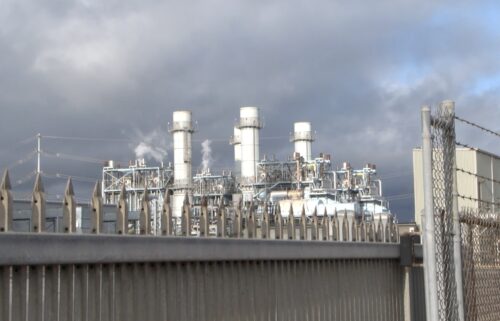The US ‘megadrought’ sets another stunning record
By Allison Chinchar, CNN Meteorologist
Despite several recent drenching rainstorms in the West and enough snow to top the second story of some buildings, the United States has tied an alarming drought record: At least 40% of the Lower 48 has gone 68 straight weeks — more than 17 months — in drought conditions.
Drought was present in nearly 55% of the contiguous US this week, according to the US Drought Monitor. The last time drought has been so widespread for so long was October 2013. And without significant and unprecedented precipitation over the next seven days, the country will be in uncharted drought territory and break that record outright.
Almost all of the US drought is located west of the Mississippi River, with extraordinarily dry conditions in far Western states, which scientists warn is a consequence of the climate crisis. Much of the West’s drought is actually a long-term phenomenon, persisting from year to year without enough precipitation to lead to a full recovery, said Brad Rippey, a meteorologist with the US Department of Agriculture.
“The Southwest has been experiencing what many scientists have termed a ‘megadrought’ for about two decades,” Rippey told CNN.
In November, US drought coverage climbed above 50% for the first time since 2013. Before the 2013 records, the US had also experienced 65 consecutive weeks of drought between March 2002 and June 2003. The US Drought Monitor has been tracking conditions since 2000.
Current dry conditions are being exacerbated by water overuse, said Michael Anderson, a climatologist with the California Department of Water Resources. When the storms come, it might not be enough to replenish the aquifers, he said.
“That can take quite a bit of time, because its water is coming back to the aquifers,” Anderson told CNN. “But water is continuing to be used, so you have to have enough water coming into the aquifer that exceeds the use for that restoration to occur.”
Oregon also saw a huge increase in precipitation in December, but it did little to bring up the reservoirs around the Rogue River Basin, where half of the reservoirs are at less than 10% of capacity.
Even as recent winter storms have helped recharge the parched Western landscape, drought has worsened in the Southern Plains, especially in Texas, where it has increased from 15% to 82% in just the last three months.
Winter rain and snow has helped, but not enough
The winter season started strong with remarkable rain and snow in December, especially in California. For the first time since December 2020, the state this week has no areas with exceptional drought — the highest designation, the US Drought Monitor reported. Extreme drought, the second-highest, is down to 1%, whereas 80% of the state was considered extreme or worse just last month.
A quarter of the state’s total average winter snowpack came in December alone, said Julie Kalansky, deputy director of operations for the Center for Western Weather and Water Extremes.
“Currently, the snowpack is at about 50% of the end of season normal snowpack,” Kalansky said. “The storms helped a lot, but if there are not some other large storms this winter, it will not be enough to end the drought.”
Other states also saw huge gains — including Oregon and Washington, where several cities broke daily rainfall records in the final month of 2021.
“We call it a great start,” Anderson said. “We are always appreciative when winter starts as fantastically as it did because that’s the kind of start we needed. The challenge is that we kind of need to sustain that through the rest of January through March.”
Rippey agreed that the West needs more storms this winter. “Despite the promising start to the Western winter wet season, additional storminess will be needed in early 2022 to sustain the recovery from a multiyear drought,” he said.
Tremendous gains in precipitation only go so far when you’re starting from such a low number, Rippey said.
“By July 1, 2021, the surface elevation of massive Lake Mead, which lies behind Hoover Dam along the Colorado River, fell to 1068.66 feet above sea level — the lowest level since the spring of 1937,” when the reservoir was created, he said.
Where precipitation falls is critical, too. California is a geographically complex state, with the highest elevation point (Mt. Whitney) and the lowest elevation point (Death Valley) in all of the Lower 48 states.
Drought in Northern and Central California is arguably more problematic than drought in Southern California, Rippey said.
“A key element of California water in that we have our large water projects in (the) north, where typically more rainfall falls,” Anderson said. “Then, we move water where there tends to be less rainfall, but there tends to be more people because the weather is really nice.”
Years where all areas of California are dry, as now, pose a stiff challenge, and people rely more on stored water and groundwater.
What this could mean for the future
Scientists have noted that the variability in precipitation isn’t just changing over the course of years but now within the same year — something they call “weather whiplash.”
“Now, even within the year, you can have a really wet month, like we did in October — we had a fantastic atmospheric river — then November comes around and it’s really dry,” Anderson said. Then, “December comes to us quite bountiful, but now we’re back in January and January is dry. That can really challenge trying to navigate that back-and-forth, unless you are prepared.”
Dry conditions aren’t just a concern for reservoirs and water supply but also for fire mitigation. Where conditions are dry, fires can spark.
In 2021, California and Colorado were hit by devastating fires that spread rapidly due to prolonged drought conditions. Wildfires in the West were the third-costliest weather disaster in 2021 at more than $10 billion.
In general, droughts that may have occurred only once every 10 years or so now happen 70% more frequently, the UN Intergovernmental Panel on Climate Change reported in August. The climate change connection is particularly strong in the Western United States, it concluded.
The-CNN-Wire
™ & © 2022 Cable News Network, Inc., a WarnerMedia Company. All rights reserved.
CNN’s Brandon Miller contributed to this report.


